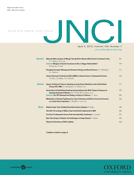导读:肥胖是很多肿瘤的危险因素,但肺癌似乎并不包括内。较多的流行病学研究发现,体重指数(BMI)(肥胖的标记物)和肺癌的发生风险成负相关。

肥胖是很多肿瘤的危险因素,但肺癌似乎并不包括内。较多的流行病学研究发现,体重指数(BMI)(肥胖的标记物)和肺癌的发生风险成负相关。但这些研究都或多或少受到潜在的混杂因素影响,如吸烟等。于是来自美国国家癌症研究所Smith等人进行了研究。研究结果近期发表在JNCI上。
这是一项前瞻性的研究,于在1995–1996年纳入了年龄在50-71岁间的448732名男性和女性。BMI根据研究对象基线时的身高和体重计访截止到2006年,平均算。随随访时间9.7年,共发生9437例肺癌患者(其中不吸烟者415例)。多元Cox比例风险回归模型来计算患肺癌危险比(HR)和95%可信区间(CI)(校正了肺癌的危险因素,如吸烟状况)。考虑到既往病史可能带来的偏倚,研究者在敏感性分析时剔除了潜在的非健康研究对象。所有的统计检验均为双侧。
研究发现肺癌的发病率为男性233例/100000人年,女性为192例/100000人年。无论是男性还是女性,BMI均与肺癌发生风险呈负相关(BMI≥35 VS 22.5-24.99 kg/m2:HR= 0.81,95%CI= 0.70-0.94和HR= 0.73,95%CI =0.61-0.87)。这种负相关仅存在于吸烟(包括既往有吸烟史)人群,且在校正吸烟因素后,这种负相关变强。在吸烟人群中进一步亚组分析,分组因素包括戒烟的时间,每天吸烟的支数等,在各亚组中BMI均与肺癌发生风险负相关。敏感性分析的结果支持这种负相关与既往病史无关。
由此可得出结论:在吸烟者中,较高的BMI可以降低肺癌的发生风险。

Body Mass Index and Risk of Lung Cancer Among Never, Former, and Current Smokers
Llewellyn Smith, Louise A. Brinton, Margaret R. Spitz, Tram Kim Lam, Yikyung Park, Albert R. Hollenbeck, Neal D. Freedman, Gretchen L. Gierach
Background: Although obesity has been directly linked to the development of many cancers, many epidemiological studies have found that body mass index (BMI)—a surrogate marker of obesity—is inversely associated with the risk of lung cancer. These studies are difficult to interpret because of potential confounding by cigarette smoking, a major risk factor for lung cancer that is associated with lower BMI.
Methods: We prospectively examined the association between BMI and the risk of lung cancer among 448 732 men and women aged 50–71 years who were recruited during 1995–1996 for the National Institutes of Health–AARP Diet and Health Study. BMI was calculated based on the participant’s self-reported height and weight on the baseline questionnaire. We identified 9437 incident lung carcinomas (including 415 in never smokers) during a mean follow-up of 9.7 years through 2006. Multivariable Cox proportional hazards regression models were used to estimate hazard ratios (HRs) and 95% confidence intervals (CIs) with adjustment for lung cancer risk factors, including smoking status. To address potential bias due to preexisting undiagnosed disease, we excluded potentially unhealthy participants in sensitivity analyses. All statistical tests were two-sided.
Results: The crude incidence rate of lung cancer over the study follow-up period was 233 per 100 000 person-years among men and 192 per 100 000 person-years among women. BMI was inversely associated with the risk of lung cancer among both men and women (BMI ≥35 vs 22.5–24.99 kg/m2: HR = 0.81, 95% CI = 0.70 to 0.94 and HR = 0.73, 95% CI = 0.61 to 0.87, respectively). The inverse association was restricted to current and former smokers and was stronger after adjustment for smoking. Among smokers, the inverse association persisted even after finely stratifying on smoking status, time since quitting smoking, and number of cigarettes smoked per day. Sensitivity analyses did not support the possibility that the inverse association was due to prevalent undiagnosed disease.
Conclusions: Our results suggest that a higher BMI is associated with a reduced risk of lung cancer in current and former smokers. Our inability to attribute the inverse association between BMI and the risk of lung cancer to residual confounding by smoking or to bias suggests the need for considering other explanations.








